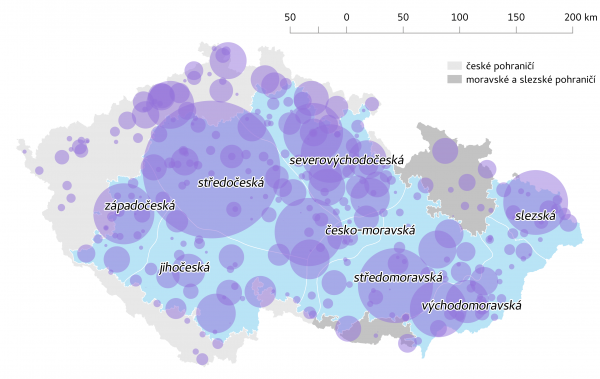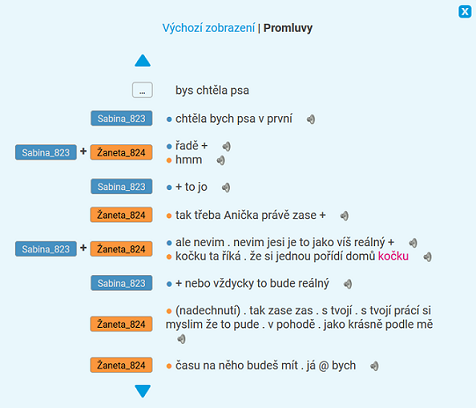This is an old revision of the document!
Table of Contents
ORAL Corpus
The ORAL corpus is a corpus containing the transcribed recordings of predominantly informal conversations taking place between native speakers of Czech from all regions of the Czech Republic. The speakers knew each other very well (they were either friends or family members) and they were recorded in their natural environment. The recordings were made over the course of ten years, between 2002 and 2011. The corpus is not balanced, with the majority of the data originating from the Bohemia region of the Czech Republic (for more visit the corpus structure; Czech only). There is only one level of transcription, and wherever it was possible, it was unified along with tokenization for all parts of the corpus. The ORAL corpus unifies the corpora ORAL2006, ORAL2008, ORAL2013 and the as yet unpublished recordings ORAL-Z. The overall size of the corpus is 5 368 391 words, with a total recording time of 582 hours. Part of the transcripts are not linked to the audio (data from the corpora ORAL2006 and ORAL2008). The corpus is lemmatized and morphologically tagged. It uses the same type of morphological tagging as the contemporary written corpora.
| Name | ORAL |
|---|---|
| Number of positions (tokens) | 6 361 707 |
| Number of positions (tokens) without punctuation or comments | 5 368 392 |
| Number of word forms (words) | 193 497 |
| Number of recorded conversations | 1 546 |
| Number of speaking turns | 696 918 |
| Number of unique (different) speakers | 1 297 |
| Length of recordings for ORAL2013 + ORAL-Z [hh:mm:ss.ms] | 354:44:36.722 |
Creating the ORAL corpus
The corpus was created by merging and correcting data from the already existing corpora ORAL2006, ORAL2008 and ORAL2013, and by adding the ORAL-Z section, which additionally contains several recordings of formal situations. These formal situations capture communication in which one of the speakers represents an institution – e.g. job interview, conversation at the office, in the shop etc., or else it can be a prepared speech, e.g. a lecture. Information about the original corpus from which the recording was taken allows us to create an identical subcorpus with corrected data and with added lemmatization and morphological tagging.
Due to corrections and changes to tokenization, even previously published sections of the ORAL corpus have changed in size. To provide an overview and a comparison with the original corpora, we have included the size of all sections in the new corpus (number of positions without punctuation and comments / total number of positions):
- ORAL2006: 999 380 / 1 149 678
- ORAL2008: 995 484 / 1 172 509
- ORAL2013: 2 749 840 / 327 5988
- ORAL-Z: 623 688 / 763 532
The absolute values for the number of speakers according to place of birth, along with longitude and latitude coordinates, are available for download in .xlsx format.
Modification of sociolinguistic data
- dialect regions (8 traditional + Bohemian and Moravian border areas) were changed based on the categories used in the ČJA (Balhar, 1992) and their borders were modified based on the latest research (see the map of dialect regions)
- marking identical speakers: in the recordings made in the years 2002–2007 (corpora ORAL2006, ORAL2008 and ORAL-Z), any cases of identical speakers were later connected, and in recordings from the years 2008–2011 (ORAL2013 corpus) this congruence had already been marked; identical speakers across both time periods were not marked
- adding an alias for the identification of the same speaker: every single speaker in the ORAL corpus is labelled with a randomly chosen Czech first name of the corresponding gender + identification number (e.g. Simona_450)1)
- newly added employment for all speakers based on the classification of employment and the percentage of the given speaker's share in the number of tokens (positions in the corpus) in the recording
- the binary categories remain the same for
- gender: female, male
- age: 18–35 years, 35 years and up
- education: lower (primary school, high school) and higher (university education - including unfinished)
Modification of segmentation
- the maximum segment length for recordings linked to audio from the ORAL2013 section of the corpus is 15 words, and 25 words for the ORAL-Z section (made longer in order for the given section to be heard better); transcripts without audio are segmented into speaker turns (one speaker's section of speech before he is superseded by his communication partner)
- a turn which was interrupted by the second speaker, following which the original topic was reestablished is marked with a plus sign
(+); if the original topic was not brought up again, it is marked with a minus sign(-) - punctuation in the ORAL2013 and ORAL-Z sections is pause-based; syntactic punctuation, used in the ORAL2006 and ORAL2008 corpora, was altered in the following way: commas were deleted with no replacement, full stops were replaced by commas
Modification of transcription
Transcription in the joint corpus ORAL retains most of the usual corpus transcription rules. However, in a number of cases they have been modified and unified 2). The transcript of sections of the ORAL-Z corpus essentially conforms to the transcription rules of the ORAL2013 corpus. The differences of the transcriptions are caused not only by errors and changed rules, but often also by the possibility of double entries in written texts.
Wherever possible, the transcription was unified in the following manner:
- written together: foreign origin words (nonstop, secondhand), quoted phrases (apriori, defacto), digraphs with two possible spellings (bezesporu, načerno, vodmalička), numerals with the component “krát” (čtyřikrát), substantivized numerals (dvacetdevítka), conjuncts (anebo, abysem), interjections (bubu, čičí, díkybohu),
- written separately: multiword contact expressions (no no; prosim tě), conjuncts (i když), numerals (čtyři sta, dvacet dva, dvacátýho devátýho), multiword adverbials (přece jenom, všude možně), expressions with a component (ne)vím (nevim kam; nevím co, bůh ví, čert ví) and and phrases with a preposition and pronoun na ňho.
- written with a lower case first letter: names of beverages (frankovka, mattonka, gambrinus), vehicle brand names (fabia, fiat, zetor), internet browsers google, youtube
Sensitive personal information is encoded in the transcription according to the wishes of the recorded speakers. More detailed information and an overview of the transcription symbols can be found in the Transcription section (Czech only).
View
For spoken corpora we have implemented a new, graphic interface for viewing dialogues, which clearly shows the alternating speakers, captures their concurrent speech (for the ORAL2013 and ORAL-Z sections) and distinctly identifies the speaker with the help of the alias.
Sources
Balhar, J. et al. (1992) : Český jazykový atlas. Academia. Praha.
Hajič, J. – Hlaváčová, J. (2013): MorfFlex CZ. Univerzita Karlova v Praze, MFF, ÚFAL, Praha.
Straka, M. – Straková, J. – Hajič, J. (2014): Open-Source Tools for Morphology, Lemmatization, POS Tagging and Named Entity Recognition. In: Proceedings of 52nd Annual Meeting of the Association for Computational Linguistics: System Demonstrations, Baltimore, Maryland: Association for Computational Linguistics, 3–18.
How to cite ORAL
Kopřivová, M. - Lukeš, D. - Komrsková, Z. - Poukarová, P. - Waclawičová, M. - Benešová, L. – Křen, M.: ORAL: korpus neformální mluvené češtiny, verze 1 z 2. 6. 2017. Ústav Českého národního korpusu FF UK, Praha 2017. Retrieved from: http://www.korpus.cz
Kopřivová, M. - Lukeš, D. - Komrsková, Z. - Poukarová, P.: Korpus ORAL: sestavení, lemmatizace a morfologické značkování. In Korpus - Gramatika - Axiologie 2017 (in print).
Lukeš. D. - Klimešová, P. - Komrsková, Z. - Kopřivová, M. (2015) : Experimental Tagging of the ORAL Series Corpora: Insights on Using a Stochastic Tagger. In: TSD 2015, Ed. P. Král a V. Matoušek. Springer international Publishing, 342-350.









